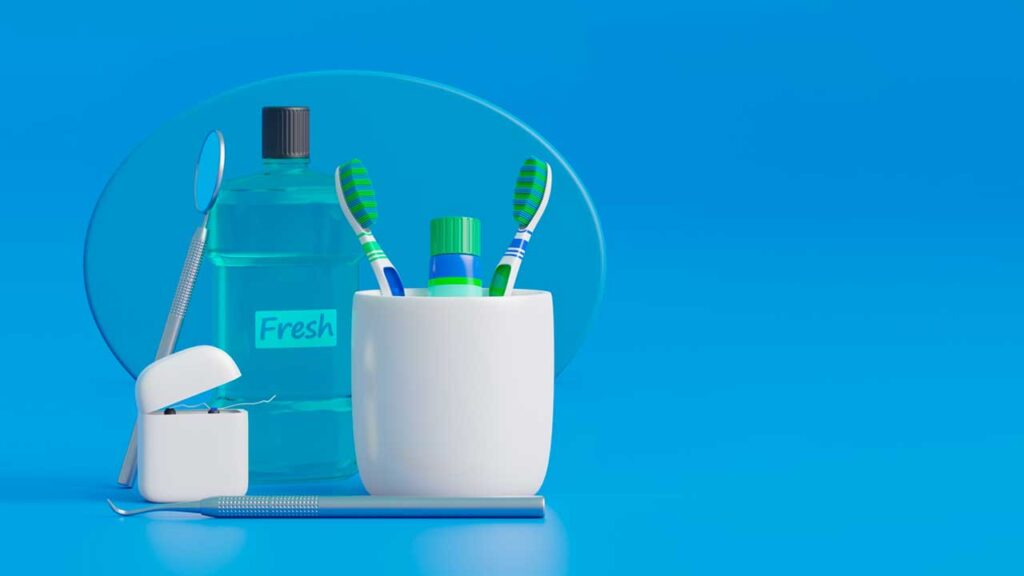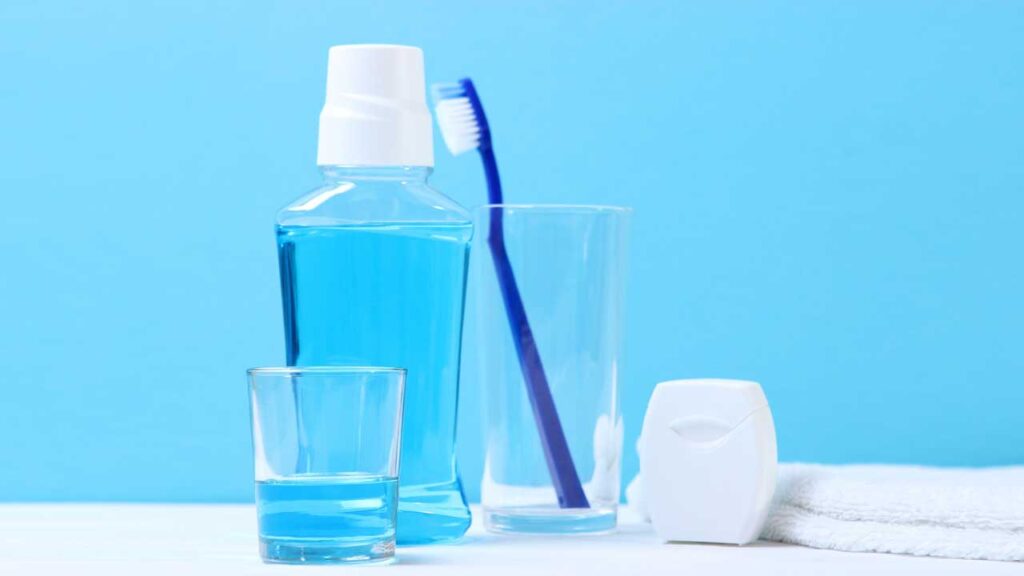Do you want to have a brighter and whiter smile? If so, you might have considered using teeth whitening rinses. These are mouthwashes that contain peroxide or other whitening agents that can help remove surface stains and lighten the color of your teeth. But do they really work? And are they safe for your oral health?
In this article, we will explore the pros and cons of teeth whitening rinses, how to use them effectively, and what alternatives are available.
What are teeth whitening rinses and how do they work?
Teeth whitening rinses are mouthwashes that contain ingredients, such as hydrogen peroxide or sodium bicarbonate, that can whiten your teeth by removing surface stains and enhancing the natural color of your enamel. They are usually used after brushing your teeth, and you need to swish them around in your mouth for about a minute before spitting them out.
Teeth whitening rinses work by creating an oxidation reaction that breaks down the organic molecules that cause discoloration on your teeth. They can also help prevent plaque buildup and reduce bad breath by killing bacteria in your mouth.

However, teeth whitening rinses are not as effective as other whitening methods, such as strips, gels, or trays, because they have a lower concentration of bleaching agents and a shorter contact time with your teeth. They can also only whiten your natural teeth, not any fillings, crowns, veneers, or dentures you may have6.
What are the benefits and drawbacks of using teeth whitening rinses?
Teeth whitening rinses have some advantages and disadvantages that you should consider before using them. Here are some of them:
Benefits
- They are easy and convenient to use. You just need to rinse your mouth with them once or twice a day, as part of your regular oral hygiene routine.
- They are relatively inexpensive and widely available. You can find them in most drugstores, supermarkets, or online shops.
- They can improve your oral health by reducing plaque, gingivitis, and bad breath.
- They can enhance your smile by making your teeth look brighter and cleaner.
Drawbacks
- They are not very effective at whitening your teeth. They can only remove surface stains and lighten your teeth by one or two shades at most. If you have severe staining or yellowing, you may need a stronger whitening treatment from your dentist.
- They can cause tooth sensitivity and gum irritation. The bleaching agents in the rinses can make your teeth more prone to temperature changes and acidic foods or drinks. They can also damage your enamel if used too frequently or for too long. Your gums may also become inflamed or sore if the rinse comes in contact with them.
- They can have side effects or interactions with other medications or supplements. Some ingredients in the rinses, such as hydrogen peroxide or sodium bicarbonate, can interfere with the absorption or effectiveness of certain drugs or vitamins. You should consult your doctor or pharmacist before using them if you have any medical conditions or take any medications or supplements.
How to choose the best teeth whitening rinse for your needs?
There are many types and brands of teeth whitening rinses on the market, so it can be hard to decide which one is right for you. Here are some factors to consider when choosing a teeth whitening rinse:
The ingredients.
Look for a rinse that contains hydrogen peroxide, sodium bicarbonate, or both, as these are the most effective bleaching agents for teeth whitening. Avoid rinses that contain alcohol, as they can dry out your mouth and increase the risk of tooth decay and gum disease. Also avoid rinses that contain artificial colors or flavors, as they can stain your teeth or cause allergic reactions.
The concentration.
The higher the concentration of the bleaching agent, the faster and stronger the whitening effect will be. However, higher concentrations also mean higher risks of tooth sensitivity, gum irritation, and enamel damage. Most over-the-counter rinses have a concentration of 1% to 3% hydrogen peroxide or 0.5% to 2% sodium bicarbonate. These are safe and effective for most people, but you should follow the instructions on the label carefully and not exceed the recommended dosage or duration.
The flavor.
The flavor of the rinse can affect how pleasant or unpleasant it is to use. Some people prefer minty or fruity flavors, while others prefer plain or neutral ones. Choose a flavor that suits your taste and does not bother you or make you nauseous.
The reviews.
Reading the reviews of other users can help you get an idea of how well the rinse works, how it tastes, and what side effects or problems it may cause. You can find reviews on online platforms, such as Amazon, or on dental websites, such as Colgate or Oral-B. However, keep in mind that everyone’s experience may vary depending on their individual factors, such as their teeth condition, their oral hygiene habits, and their expectations.
How to use teeth whitening rinses safely and effectively?
To get the best results from using teeth whitening rinses, you should follow these tips:
- Brush your teeth before using the rinse. This will remove any food particles or plaque that may interfere with the whitening process.
- Shake the bottle well before using the rinse. This will ensure that the ingredients are well mixed and distributed.
- Pour the recommended amount of rinse into a cup or measure it with a cap. Do not use more than the suggested dose, as this may cause adverse effects or waste the product.
- Swish the rinse around your mouth for about a minute, making sure to cover all your teeth. Do not swallow the rinse, as this may cause stomach upset or harm your health.
- Spit out the rinse and do not rinse your mouth with water or anything else. This will allow the bleaching agent to stay on your teeth and continue working.
- Repeat the process once or twice a day, preferably in the morning and at night, for two to four weeks or until you achieve your desired shade of whiteness.
- Stop using the rinse if you experience any severe or persistent tooth sensitivity, gum irritation, enamel damage, or other side effects. Consult your dentist if the symptoms do not go away or worsen.
What are the Alternatives to Teeth Whitening Rinses?
If you are not satisfied with the results of teeth whitening rinses or if you experience any adverse effects from them, you can try other whitening methods that may be more effective and safer for your teeth.
Some of them are:
Whitening toothpastes.
These are toothpastes that contain abrasive particles or enzymes that can help remove surface stains from your teeth. They can also contain fluoride or other ingredients that can protect your teeth from decay and sensitivity. However, they cannot change the intrinsic color of your teeth or whiten your dental work.
Whitening strips.
These are thin strips that are coated with peroxide or other whitening agents that you apply to your teeth for a few minutes a day. They can whiten your teeth by several shades and last for up to a year. However, they can also cause tooth sensitivity, gum irritation, or uneven whitening if not used correctly.
Whitening trays.
These are custom-made or over-the-counter trays that you fill with peroxide or other whitening gels and wear over your teeth for a few hours a day or overnight. They can whiten your teeth by several shades and last for up to a year. However, they can also cause tooth sensitivity, gum irritation, or enamel erosion if not used correctly.
In-office whitening.
This is a professional whitening treatment that is performed by your dentist in a single session. Your dentist will apply a high concentration of peroxide or other whitening agents to your teeth and activate them with a light or heat source. This can whiten your teeth by several shades and last for up to a year. However, this is the most expensive and invasive whitening method and may require multiple sessions to achieve the desired results.
What are some alternative ways to whiten your teeth naturally?
If you are not satisfied with the results of teeth whitening rinses or want to avoid using chemicals on your teeth, you can try some natural methods to whiten your teeth at home. Here are some of them:
Baking soda.
Baking soda is a common household ingredient that can act as a mild abrasive and remove surface stains from your teeth. You can mix it with water or hydrogen peroxide to make a paste and brush your teeth with it once or twice a week. However, do not use it too often or too hard, as it can damage your enamel and make your teeth more sensitive.
Coconut oil.
Coconut oil is a natural oil that has antibacterial and anti-inflammatory properties. It can help reduce plaque, gingivitis, and bad breath by killing harmful bacteria in your mouth. It can also whiten your teeth by removing stains and improving their appearance. You can use it for oil pulling, which is a technique that involves swishing a tablespoon of oil around your mouth for 15 to 20 minutes before spitting it out. You can do this once a day, preferably in the morning before eating or drinking anything.
Apple cider vinegar.
Apple cider vinegar is a fermented liquid that contains acetic acid and other organic acids. It can help whiten your teeth by breaking down stains and restoring their natural color. You can dilute it with water and use it as a mouthwash after brushing your teeth. However, do not use it too often or too long, as it can erode your enamel and cause tooth decay and sensitivity.
Fruits and vegetables.
Fruits and vegetables are rich in vitamins, minerals, antioxidants, and enzymes that can benefit your oral health and whiten your teeth. Some examples are strawberries, pineapples, lemons, oranges, apples, carrots, celery, and broccoli. They can help remove stains by acting as natural abrasives or bleaching agents. They can also stimulate saliva production and neutralize acids in your mouth. You can eat them raw or mash them and apply them to your teeth for a few minutes before rinsing them off.
Teeth whitening rinses are one of the many options available for improving the appearance of your smile. They are easy to use, affordable, and effective for removing surface stains and enhancing the natural color of your enamel.
However, they are not very powerful at whitening your teeth and they can cause some side effects, such as tooth sensitivity, gum irritation, and enamel damage. Therefore, you should use them carefully and follow the instructions on the label. You should also consult your dentist before using them if you have any dental problems or concerns.

2 thoughts on “The Role of Teeth Whitening Rinses in Maintaining Oral Health”